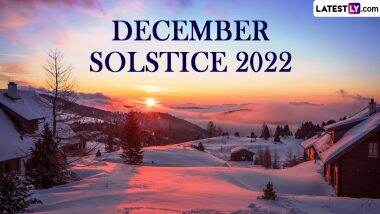The December solstice falls in the month of December but may vary by one day in either direction, according to the Gregorian calendar. December solstice is also known as the Winter Solstice. This year, the winter solstice falls on Thursday, December 22, 2022. In the Northern Hemisphere, the December solstice is the winter solstice, which is said to be the day with the shortest period of daylight, while in the Southern Hemisphere, it is the summer solstice, the day with the most extended period of daylight. This means that the December solstice marks the shortest day north of the equator and the longest day in the south. Scroll below to learn more about the history and significance of the December solstice. Winter 2022 Seasonal Fruits: From Oranges to Pomegranates; Savour These Must-Have Winter Fruits And Know All About Their Health Benefits.
History of December Solstice
The history of solstice dates back to the Neolithic times, as the event was part of the annual cycle for some cultures. These events were often used to guide activities, such as mating animals, sowing crops and monitoring winter food reserves. The December solstice is when the Sun is directly above the Tropic of Capricorn in the Southern Hemisphere. Summer Solstice 2022 Date & Time: When is The Longest Day of The Year? Know Midsummer Traditions, Facts, Significance And Everything About The Event.
The length of the December solstice has been relatively stable between 6000 BC and AD 2000, in the range of 49 minutes 30 seconds to 50 minutes in excess of 365 days 5 hours. After 2000, it has been growing shorter. In 4000, the excess time will be 48 minutes 52 seconds, and, in 10000, 46 minutes 45 seconds.
December Solstice Significance
December solstice has great significance as it marks the start of winter in the Northern Hemisphere and the start of summer in the Southern Hemisphere. The exact date of the earliest sunset depends on your latitude. The December solstice can be on December 20, 21, 22, or 23. The date of the solstices varies because a year in our calendar does not precisely match the time it takes the Earth to complete an orbit around the Sun.
The Gregorian calendar has 365 days in a typical year and 366 days in a leap year. However, Earth takes about 365.242199 days to orbit the Sun, which clearly states that the timing of the equinoxes and solstices slowly drifts apart from the Gregorian calendar, and the solstice happens about six hours later each year.
(The above story first appeared on LatestLY on Dec 15, 2022 09:31 PM IST. For more news and updates on politics, world, sports, entertainment and lifestyle, log on to our website latestly.com).













 Quickly
Quickly











